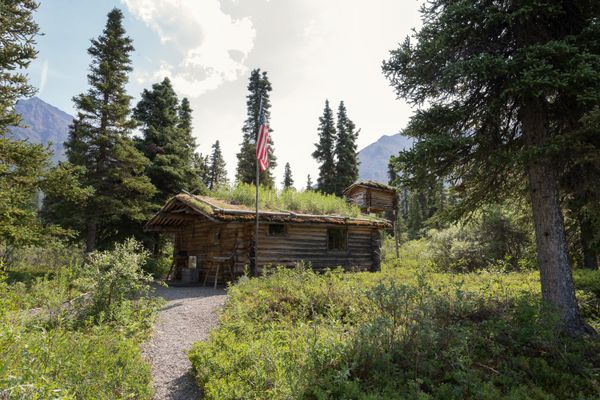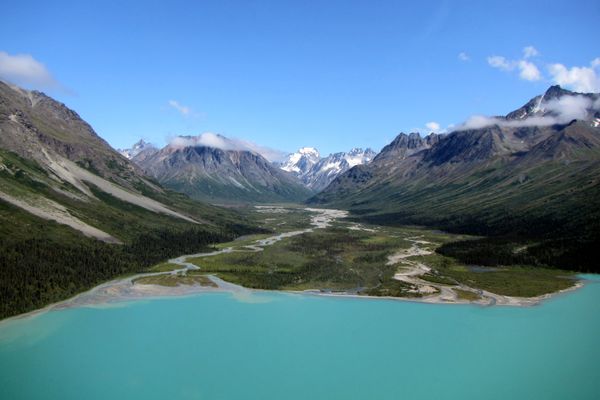The late naturalist’s remote lifestyle has captivated Americans—myself included—for decades. Would a visit to his off-grid wilderness shack live up to its beloved image?
It’s late June, and after endless emails, Grizzly bear warnings, phone calls, gear checks, and numerous logistical hurdles, I’m in a tiny floatplane in the middle-of-nowhere Alaska, on a quest to visit a beloved, rustic cabin about the size of a single-car garage.
Most passengers would be scanning Lake Clark National Park’s vast wilderness for caribou or moose. I’m looking for a gabled sod-and-moss roof. When the pilot descends, he dips a wing, and there it is out of a tiny window: the flagpole, the elevated food cache, and that beautiful cover. I can almost taste the sourdough biscuits.
“Well, there’s Dick’s cabin,” the pilot says.
Millions have seen self-educated naturalist Richard Proenneke’s 192-square-foot Alaskan bush-style cabin on television and YouTube, but few have set foot in it. Lake Clark National Park is one of America’s least-visited national parks. There are no roads to get there and, according to park officials, only about 1,400 people visited the cabin last year, up about 300 from the previous year. “It’s a tough place to get to,” says Chelsea Niles, Lake Clark’s visitor services program manager. “It’s a testament that people make an effort and find a way to get there.”

Dick Proenneke’s cabin and cache, surrounded by vegetation, which helps it blend into the forest. Proenneke used the cache to store goods.
Photo by T. Vaughn/National Park Service
I’ve found people either haven’t heard of Proenneke, or they are devotees, like me, enthralled by Alone in the Wilderness, the documentary that started airing on PBS in 2004. The National Park Service had previously produced a short documentary about Proenneke, featuring footage he’d taken to send to his family, called One Man’s Alaska. Later, a man named Bob Swerer obtained the original footage from Proenneke and made Alone in the Wilderness, along with a sequel.
Like a modern-day social media influencer, Pronneke filmed chunks of his life to send to his family, setting up a 16-millimeter camera on a tripod. Today, the YouTube videos, showing him crafting the cabin’s iconic Dutch door with wooden hinges or feeding birds by hand, have garnered millions of views. On the fan-run @proennekenature TikTok channel, almost 46,000 people have watched him carve a spoon. “This man lived every man’s dream,” one comment on YouTube reads.
I owned the DVD—it’s like ASMR for outdoorsy types—and, later, One Man’s Wilderness: An Alaskan Odyssey, the 1973 book based on the journals he kept there. An Iowa native, Proenneke was a U.S. Navy veteran, master diesel mechanic, and photographer, and, perhaps, accidentally, a modern transcendental philosopher. “I have found that some of the simplest things have given me the most pleasure,” Proenneke wrote in One Man’s Wilderness. “They didn’t cost me a lot of money either. They just worked on my senses. Did you ever pick very large blueberries after a summer rain, walk through a grove of cottonwoods, open like a park, and see the blue sky beyond the shimmering gold of the leaves? Pull on dry woolen socks after you’ve peeled off the wet ones? Come in out of the subzero and shiver yourself warm in front of a wood fire? The world is full of such things.”
I wanted to feel those simple pleasures, even if getting there wasn’t so easy. I wanted to wear the wool socks.

Proenekke lived alone in the cabin he built by hand for nearly 30 years.
Photos by Richard Proenneke, courtesy National Park Service
A cabin is like a dream, a simple place where you can become the best version of yourself. You might whittle a walking stick by the fire or cook bacon on a skillet while your new buddy, a red fox, waits for scraps. Maybe you’ll finish your novel or unplug from social media forever, or at least for a long weekend.
My first cabin was the Polish Ponderosa, a log home my aunt and uncle built on a sandy patch of pines in New Jersey in the 1970s after a trip to New Mexico. Decades later, it’s still owned by my family, a beloved anachronism encircled by newer, Sopranos-esque mansions.
On sleepless nights, I scroll cabin listings all over the world. I message real estate agents in Maine and the Adirondacks (Are there loons on the lake? Are you sure I couldn’t access it in the winter?), but I don’t answer their calls. Some argue that the cabin obsession is part of a conservative fantasy, or an “escape from late capitalism’s ceaseless demands of labor and attention.” I admit to the latter, but most of my fantasies aren’t fiscally conservative. Last year, a vast compound with three vintage cabins built by the Gumbel Brothers of Pennsylvania on Lake Wallenpaupack broke my heart. It was selling for about $4 million, and I played the lottery a few times, desperate to own it.
What about Proenneke’s simple, tiny, off-grid design? Earlier this year, I posted on the r/cabins SubReddit, asking if anyone had blueprints for it. It couldn’t be too pricey to build if I found the land. But you can’t grab free waterfront parcels with mountain views in modern America anymore. Coincidentally, though, in February, Alaska Governor Mike Dunleavy proposed a bill that would allow residents to build “dream cabins on state land” via purchase or lease of up to 10 acres. Dunleavy told me it’s a way to own a piece of the “last frontier.”
“We have lots of land and we want to get it into the hands of people,” he says.
On Zillow, “cabin” was the fourth most popular feature search in 2024, behind “ranch style,” “lake,” and “duplex.” What constitutes a cabin, though? Are logs a must? Does a gas fireplace ruin the vibe? Could a cabin exist in the city? I asked people who’ve seen their fair share, like Lindsay Bro, a Southern California writer who founded the @cabinlove Instagram page in 2013. Today, with almost half a million followers, Bro’s visited hundreds of cabins, and she’s open-minded about the definition.
“For me, it’s a small space, set far away,” she says. “When you say the word ‘cabin,’ everyone immediately has some version of it they jump to. Their summer camp when they were a kid; their aunt and uncle’s place; or that one spot they’ve always been dreaming of going.”

An aerial view of Upper Twin Lake in Alaska’s Lake Clark National Park.
Photo by E. Booher/National Park Service
See the full story on Dwell.com: A Pilgrimage to the Original Viral Cabin: Dick Proenneke’s Alaska Home
Related stories:



